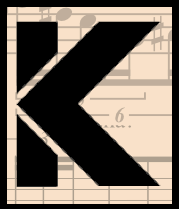|
This is the first post in a series of group album reviews I'll be doing moving forward. Every 3-4 months I’ll present a review of numerous albums released roughly within that timeframe (+/- a month or so). My goal is to (hopefully) provide album reviews more frequently and to include more albums. This inaugural post will include some standout albums from New Focus Recordings released between late 2018 through now. I’ll be including more albums from earlier in 2019 in my next review, but I hope you enjoy the following (links to artists, albums and labels included).  Ogni Suono - SaxoVoce (New Focus Recordings, 2018) Ogni Suono (Noa Even and Phil Pierick) have created something truly unique with SaxoVoce, a collection of pieces for two saxophones with voice ranging from singing to narration to pitched/non-pitched vocalizations, in addition to a wide range of extended saxophone techniques and timbres. Kate Soper’s OTOTOI presents an engaging exploration of the widest range of the instruments though a relatively limited palette of sonic materials that develop slowly over time. Sheets’ “dare-gale, speaks and spells” is an impressive composition that’s executed incredibly by Ogni Supono, at times sounding like more than 2 saxophones with the complex contrapuntal framework of notes, noises and vocalizations. Christopher Dietz’s ”My Manifesto and Me” is superficially a humorous reworking of the Rifleman’s Creed from the movie Full Metal Jacket, but with some ring undertones enhanced by the saxophone accompaniment and methods of narration. The text acts as the centerpiece of this composition with the saxophones acting in a supporting role through pointed articulations, frenetic key clicks, and swirling low drones. Dietz’s piece is one that really allows the duo to shine in their ability to not only vocalize, but deliver a powerful text through narration and self-accompaniment. Chris Fisher-Locchead’s Chroma is an interesting exploration of the timbral characteristics of the saxophones and voices through seamless transitions voice to saxophone or both in an extended through-composer formal structure. Walking After Midnight by David Reminick demonstrates the Even’s and Pierick’s singing abilities. Though Reminick specifies that “vocal training is not required,” Even and Pierick bring the same level of craft and execution as they do with all other elements of each piece on the album. Reminick’s creative use of syncopated rhythms, text painting and rapid transitions between singing and playing create a musical and textual narrative that remains consistently engaging throughout both movements. Felipe Lara’s Vocalise II is an impressive work that presents a barrage of material that coalesces into a single sustained drone. Once the drone arrives the players present melodies and gestures in fragments, noises, inhaling, and other instrumental and vocal noises. Between the fractured melodies and vocalizations moments of consonance and repose begin to appear over the drone in the thicket of disjointed and contrasting materials. Erin Rogers’ “Clamor” involves percussive noises and energetic rhythmic counterpoint interspersed between spoken phrases, similar to the Dietz’s piece earlier on the album. The fragmented phrases seem to be nonsense, but there are clear elements of the text relating to modern political concerns and issues surrounding capitalism. Fans of Rogers’ work with thingNY and Popebama will surely be pleased with her contribution to this album, and it acts as the perfect closer to an incredibly ambitious and wonderfully executed album. LINK TO CREDITS AND MORE DETAILS LINK TO OGNI SUONO WEBSITE 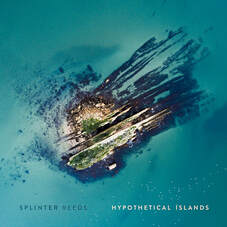 Splinter Reeds - Hypothetical Islands (New Focus Recordings, 2019) Hypothetical Islands by Splinter Reeds is unlike any album I’ve heard by a woodwind chamber group - Splinter Reeds being specifically a reed quintet. Matthew Shlomowitz’s “Line and Length” is the opening track, and presents a dense contrapuntal texture that coalesces into an almost hypnotic repetition of ideas in the final third of the piece to a climax of dissonant chords and multiphonics, ending with melange of smearing glissandi and pointillistic outbursts in irregular repetition. It’s a fitting opening for the general character of the album and the ensemble. Cara Haxo’s “Exercises,” inspired by Raymond Queneau’s Exercises In Style, offers a nice contrast as the second track. The first movement consists of mechanical overlapping grooves layered under/juxtaposed against more lyrical melodies that are constantly evolving. The second movement is similar but with an entirely slow polyphonic lyrical texture, all of which can be characterized as a tapestry of slowly evolving moments derived from a limited amount of materials cleverly reworked over and over. Eric Wubbels “Auditory Scene Analysis” opens with a nearly inaudible swirl of quiet high-pitched notes from each instrument reminiscent of a creaking metal gate. Just as the listener embraces the quiet texture a flurry of accented slap tongues and aggressive multiphonics breaks apart. This continues until the percussive articulations morph into a rhythmic groove that dissolved into a single sustained pitch that is passed from one instrument to another. Flurries of trills, tremolos, articulations, and short scalar passages are interspersed around the pitch. The piece closes with a barrage of high-register trills and growls amid persistent multiphonics that come to a grinding halt and a short coda. Theresa Wong’s “Letters to a Friend” explores the more percussive nature of the instruments through reworking rhythmic cells of key click, slap tongues and staccato articulations. The build-up of textures and energy always reminds me of a machine that’s revving up, getting more intense with each build. The final moments of the piece are a slow, almost meditative, reworking of the previous material against a backdrop of a drone and short bursts of trills from the instruments. Sky Macklay’s “Choppy” opens with an onslaught of multiphonics and guttural growling from the instruments in evolving into a secondary layer of overlapping rising phrases. The listener goes on a journey that explores moments of transformations of sustained tones, rising and falling cascades of notes in near-unison, and repetitive riffs that seem simultaneously out of sync and yet perfectly in time. The group performs the tightly controlled chaotic transformations with the utmost skill. The final piece on the album the title track “Hypothetical Islands” by Yannis Kyriakides, which blends the ensemble with electronic sounds. He refers to the piece as “an acoustic atlas, a carto-sonic fantasy on the notion of remote desert spaces.” I would say that imagery comes through in the dense texture of sustained electronic drones that at times sit under the group and at other moments overtake them, but neither ever comes off as overpowering. The instruments present short melodic phrases of limited pitch material, almost like bird calls or meditative chanting. At 13.5 minutes this is the longest track on the album, but the reflective and mesmerizing weave of gestures and timbres makes it feel like a brief moment, but one that could last forever, which I personally wouldn’t mind. One aspect that really stands out is the overall production. As an engineer myself that’s one element of classical recordings I put a lot of emphasis on, and Hypothetical Islands delivers hand over fist. James Riotta (recording engineer), Zach Wiley (mixing and mastering) and Eric Wubbels (producer) deserve their own praise for creating such an incredible artifact of these works and Solinter Reeds’ performances LINK TO CREDITS AND MORE DETAILS LINK TO SPLINTER REEDS WEBSITE 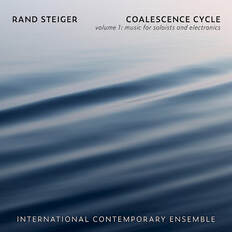 Rand Steiger - Coalescence Cycle Vol. 1 (New Focus Recordings, 2019) The International Contemporary Ensemble does a masterful job in bringing Rand Steiger’s music to life on Coalescence Cycle Vol. 1, an album of pieces for instruments and live electronics. What really gripped me about this album was the craftsmanship in integrating the live processing of the instruments in each piece, all of which display a complex web of counterpoint and dialogs between the acoustic instruments and electronics. Steiger’s compositions are unified through his idiosyncratic style and aesthetic - gesturally driven atonal music with a sensitivity to timbre and spectral processing techniques - but each track feels like a breath of fresh air and uniquely separate from one another. Because these works are all by Steiger and have a fairly homogenous sound, and because each piece is so dense, I feel the best approach would be a general overview of the character of each piece as opposed to a more in-depth treatment. The album opens with Cycle performed by Joshua Rubin and serves as an exciting introduction to the album in terms of style and energy. This is matched by Claire Chase’s performance of Beacon, with the energy and intensity of the more active/angular passages executed as skillfully as the subtlety and nuance of Steiger’s more lyrical and subdued melodic writing. Chase’s performance of Light on Water is equally captivating. The two works that stood out most to me were Mourning Fog for cello and live electronics performed by Kivie Kahn-Lipman. It’s a 17.5-minute juggernaut that incorporates nearly every element of Steiger’s other works into a cohesive whole that keeps the listener engaged from start to finish. Concatenation for bassoon and electronics, performed by Rebekah Heller. This piece is impressive for the approach to the live processing that seems to adapt to the performer, creating an electronic landscape that’s always shifting and simultaneously maintains a unified identity against, and alongside the bassoon. I strongly suggest this album for anyone who is a fan of the International Contemporary Ensemble, as this demonstrates some of the soloists performing at the highest level. I would also suggest if you’re not familiary with Rand Steiger’s music this would be a great place to start. Each piece offers a glimpse into the various styles and sonic landscapes you’ll find in his music, and his own unique approach to live processing. LINK TO CREDITS AND MORE DETAILS LINK TO RAND STEIGER'S WEBSITE LINK TO ICE'S WEBSITE 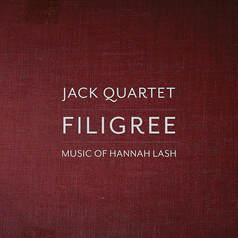 JACK Quartet: Filigree - Music of Hannah Lash Filigree is JACK Quartet’s release of a collection of music for string quartet by composer Hannah Lash. I had not been very familiar with much of Lash’s output prior to this album, but after a number of listening I plan to explore more of her work. Obviously the playing is top-notch, as JACK brings to all of their performances and recordings. Additionally, Lash’s variations of style from one piece to the next was very refreshing. I generally don’t listen to albums of music by a single composer from start to finish, but I found this particular album very easy to listen to in that way. I think this is a testament to Lash’s skill as a composer to craft engaging pieces in a variety of styles, as well as JACK’s ability to breathe life into any piece with the utmost sensitivity, regardless of style. The opening track, “Frayed”, is a huge standout. Because this album was my first time really listening to Lash’s music I wanted to really explore it in detail. My first time through the album I listened to this particular piece 2-3 times before I moved to the next track. The interplay between long sustained chords - with varying degrees of dissonance - juxtaposed against more violent outbursts of heavy bowing and distorted overpressure created a dichotomy of sound worlds I could live in forever. Pulse-Space is also an impressive composition and demonstrates incredible dedication and execution of a single idea. The piece introduces a strict pulsing rhythm from the start and explores variations of that idea through altering speeds, registers, harmonic content and layers surrounding the pulse. The remaining tracks on the album are equally engaging, and if you’re not familiar with Hannah Lash’s work I highly encourage picking up a copy of this album. LINK TO CREDITS AND MORE DETAILS LINK TO HANNAH LASH'S WEBSITE LINK TO JACK QUARTET'S WEBSITE 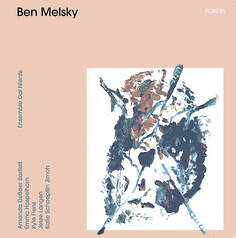 Ben Melsky - New Music for Harp Ben Melsky’s New Works For Harp is an album I received just before it was released and I still cannot stop listening to it. I’ve had the pleasure of hearing Ben perform live on a number of occasions, both as a soloist and with members of Ensemble Dal Niente. With each performance he makes me rethink the harp and what it is capable of, and this album is no different. The composers on this album often use Ben’s skill and creativity as a performer to ask him to do a number of nonstandard techniques, or at least playing techniques that casual harp listens are likely not accustomed to hearing. Melsky intertwines these sounds of half-pedaling (creating a rustling gritty tone), string harmonics, and a wealth of other techniques using implements against the strings creates a varied sound world that at times makes the listener question the specific sound sources. Beyond Melsky’s performances there is a host of other players who contribute to this album including Jesse Langen (guitar), Emma Hospelhorn (bass flute), Katie Schoepflin Jimoh (clarinet), Kyle Flens (percussion), and Amanda DeBoer Bartlett (soprano). Tomás Gueglio’s After L’Addido/Felt opens the album and demonstrates Melsky’s skills as a soloist with a piece that is truly remarkable in terms of the timbral and expressive exploration of the glissandi - arguably the most recognizable and frequently associated with the instrument. The variation that Gueglio demands from the harp, all of which Melsky delivers with commanding control (some of the techniques the two developed together. The second movement, Felt, is much slower and reflective with more time taken between moments and a stronger focus on pitch and melody. Alican Camci’s Perde for harp and bass flute follows as the third track. Camci extensively explores and utilizes the timbral possibilities of the instruments, not only for variations/deviations from more standard playing techniques, but as sonic elements existing on their own merits and the primary material. The piece uses Persian religious poems called masnavi as source material with the music for flute and harp being transcriptions of these highly rhythmic poems. This comes through in the conversational nature, as well as the voiced/spoken elements through the flute and the percussive techniques from the instruments, both layered and in unison. Fredrick Gifford’s Mobile for harp and guitar presents the two instruments playing a limited amount of pointillistic materials that are constantly reworked and varied throughout the piece, creating irregular overlaps and constantly shifting textures and layers. This is reinforced from the two instruments having similar timbres which creates, at times, an otherworldly kind of super-instrument where the harp and guitar seem to fuse into a single entity. After Some Remarks by Wang Lu, for bass clarinet and harp, draws inspiration from Christian Wolff’s approach to controlled and structured improvisation. Like other compositions on the album, Lu takes a deep dive into exploring and utilizing extended techniques of the two instruments, opening with throbbing multiphonics in the bass clarinet with resonant harmonics, plucks and glissandi from the harp interspersed. As the piece unfolds the clarinet begins playing short sustained tones while the harp continues to present material in less conventional playing techniques, all of which expands the overall timbral and color palette. Igor Santos’ Anima for percussion and harp is a mechanical presentation of a broad spectrum of percussive sounds from the harp and percussion instruments. The interplay of the two creates overlapping loops of material that are interlocked rhythmically. This particular method continues throughout the opening section of the piece and leads into a much slower and more expansive middle section that explores more sustained and howling timbres/gestures from both instruments. Both sections are contrasted by a short return to the rhythmic layering but with more frenetic rhythmic variation and followed by a short coda of gritty scratching noises from both instruments. On-dit by Eliza Brown, for soprano and harp, fuses scratchy sounds from the harp and breath of the voice in the introductory section to create a fused timbre of the two elements, which blossoms into Melsky’s impeccable playing and a top-tier performance by soprano Amanda DeBoer Bartlett singing a fragmented text by Voltaire. The piece is an appropriate closing to the album, as Brown’s single composition - as well as the performances by DeBoer Bartlett and Melsky - is delicate though intense, broad in scope yet amazingly focused and executed with the utmost skill, all of which could be said for each piece/composer on the album and for all performances. This is truly a remarkable album that I believe will reshape how most people think about the harp in terms of its sounds and expressive capabilities. LINK TO CREDITS AND MORE DETAILS LINK TO BEN MELSKY'S WEBSITE
0 Comments
Leave a Reply. |
Reverberations is a catch-all page for everything that doesn't fit into a neat and tidy box of blog posts and interviews. Enjoy!
Full Directory of Reviews |
